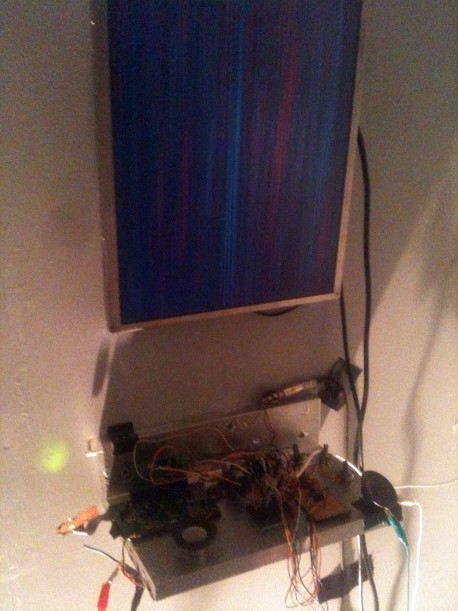Dylan Sheridan (AUS)
In response to the 'networked' part of the title for this event, I originally began to construct a circuit bent colour organ comprised of various hacked toy instruments and old TV -games. I interconnected the hacked circuits so that they were responding to each other to create a domino glitch effect; playing a note on a keyboard would produce a visual glitch in a TV game which would in turn cause a glitch in another circuit and so on. This resulted in a gloriously glitchy cacophony of colour and sound. It was all working wonderfully until, very recently, it blew up.
v-frown is the dying remains of that colour organ. One of the last remaining circuits (a V - Smile) still powers up and continues to send out rapid and irregular rhythmic pulses. I have installed a button next to the work which allows the viewer to control the fate of this last circuit - pushing it increases voltage which intensifies sound and visuals, but this drastically reduces its life span. Push with care.
Dylan Sheridan is a composer and sound artist from Tasmania, Australia. He began his formal studies in composition at the Tasmanian Conservatorium of Music, studying with Douglas Knehans & Don Kay. Dylan completed his Master’s Degree at the College-Conservatory of Music in Cincinnati, USA, where he studied with Joel Hoffman. Dylan is also a visual artist. He is interested in expanding the theatrical nature of concert music through the use of image, lighting, musical sculpture and unconventional use of space. His works have been performed in concert halls, festivals, art galleries and living rooms in Australia, the USA and Europe, by individuals and ensembles such as the Café MoMus ensemble (U.S.A), Tim Munro (from Eighth Blackbird), and the Hobart Wind Symphony, and performed at events such as the MusicX festival (Switzerland), and MONA FOMA (Hobart).
Responding Artist
dylansheridan.com
v - frown
Artist Text Response
3 DAY RITUAL
The workshops throughout the 3 day ritual introduced me to basic linux command line skills, an area I was not previously familiar with though have always wanted to investigate so I was excited at the opportunity to do so. The workshop provided a great introduction and was inspiring enough for me to continue learning myself through online tutorials etc. I would very much have like the workshops to go a little deeper or to continue over 4 or 5 days - I did not feel that I had learned enough over the three days to make a meaningful artistic response with those skills alone, though I very much hope to develop and utilize these skills in future projects.
The number of participants was good (15?) - any more would have been too many as we had to wait for each person to catch up before we could move on.
TALKS/ LECTURES
The talks were all very interesting (particularly those by Florian Cramer). I felt that the night lectures would have benefited from being presented in a more traditional lecture format, rather than as part of an opening - I was very interested in the content but was distracted by the people walking in and out, and talking in the other room. It would have perhaps been easier to focus and engage if one thing was happening at a time (talks were followed by drinking / socializing / opening vibe ). I particularly enjoyed the debate between Jeff Malpas and Florian Cramer and would have like to see it continue.
NETWORKING
the workshops were really great opportunity to meet other artists who were working with, or interested in working with technology. There were many local artists I had not previously met and all with quite diverse practices, which made conversations particularly interesting.
MY PROJECT
My initial project was to be called Colour Organ #2 . (My first colour organ was based on mathematical relationships between frequencies of light and frequencies of sound, as proposed by Scriabin. In this work i wanted to create a more chaotic and randomized colour organ)
In my response I did not directly utilize the skills I acquired at the workshops, though I was very much inspired by Rosa Menkman’s presentation and reading her publication The Glitch Momentum, which contains a section outlining various file formats and compressions and their glitch potential.
I experimented with manipulating video and audio signals in real time by passing them through numerous signal converters and other unrelated circuits to try and create a somewhat controllable chaos of sound and visual. As described in the work description however this process sadly caused irreversible damage to some of the circuits. I am grateful for the opportunity to experiment and the encouragement to continue with my initial project despite the fact that it was not turning out as planned. Continuing forced me to change my approach to working with circuit bent technology - I found that when I tried to control it and make it do what I wanted (which I couldn’t) it was incredibly stressful, but when I allowed the project do what it wanted, the result was much more successful.

Installation detail of v-frown
Photo: Nick Smithies